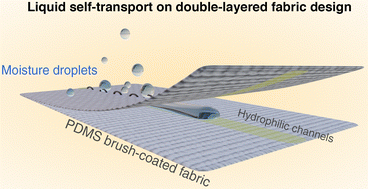Surface-engineered double-layered fabrics for continuous, passive fluid transport†
Abstract
Textiles with a wicking finish transport moisture away from the skin, such that it is exposed to the environment for fast evaporation, aiding in thermophysiological comfort. Once saturated, such as in highly humid environments or if the wearer dons multiple layers, the efficacy of such a finish is substantially reduced. Here, we develop a new type of fluid transport textile design by combining physical and chemical wettability patterns to transport and remove liquids like sweat. First, a non-toxic, superhydrophobic fabric finish is developed that retains the air permeability of the fabric. Next, two superhydrophobic fabric layers are threaded together, containing wettability channels patterned at the inner/interior side of the fabrics. This design allows for liquid transport through the stitches to the interior channels and keeps both external faces dry. The developed strategy enables directional fluid transport under highly humid conditions, resulting in a ∼20 times faster transport rate than evaporation-based methods. The design principles described here can be used to provide thermophysiological comfort for users in extreme conditions, such as firefighters, law enforcement personnel, and health workers wearing personal protective ensembles.

- This article is part of the themed collection: Materials Horizons Emerging Investigators Series 2022/2023


 Please wait while we load your content...
Please wait while we load your content...